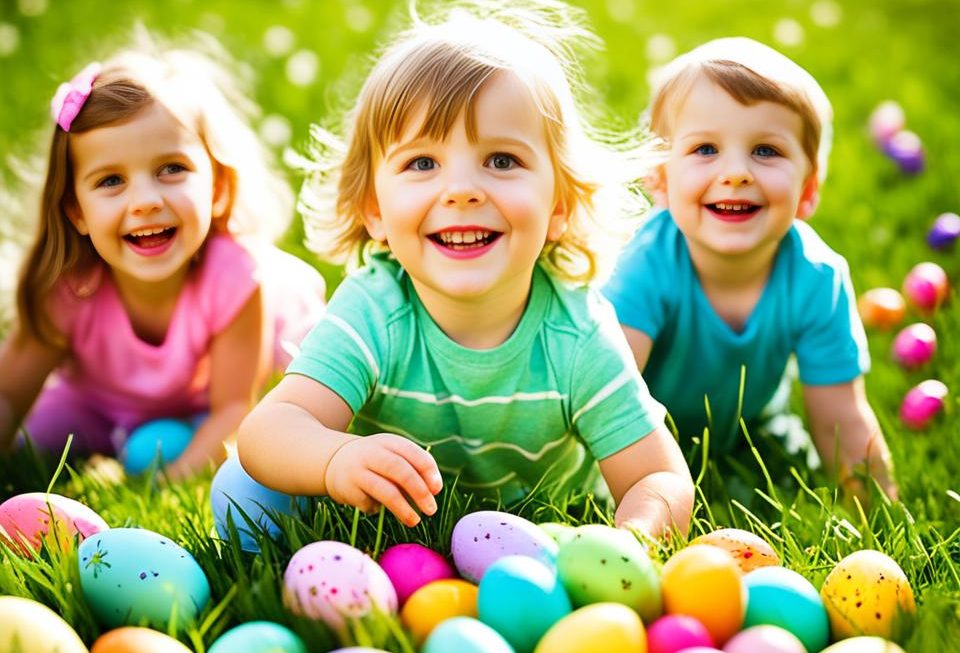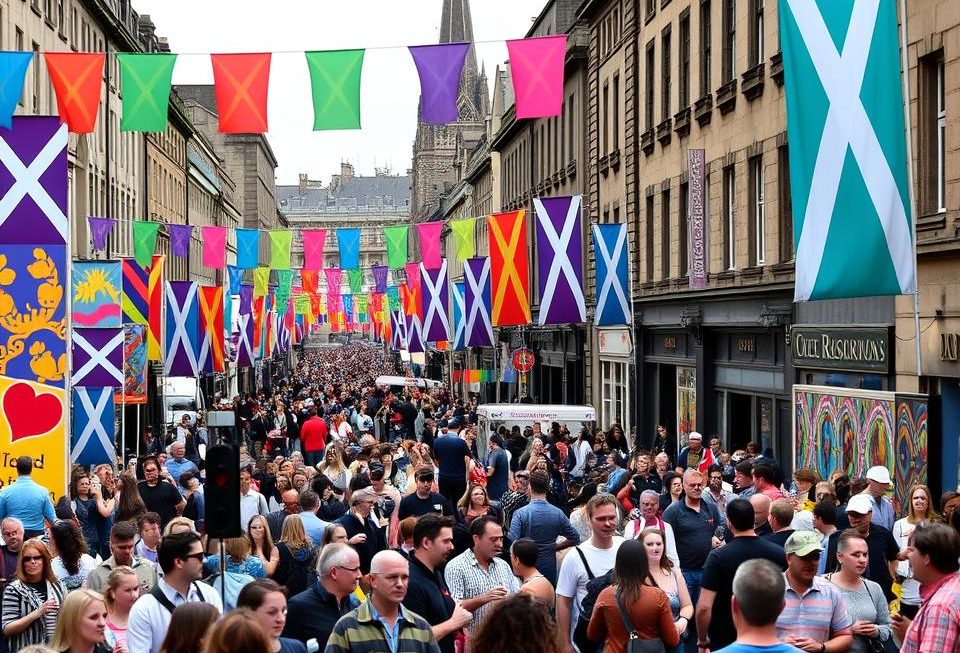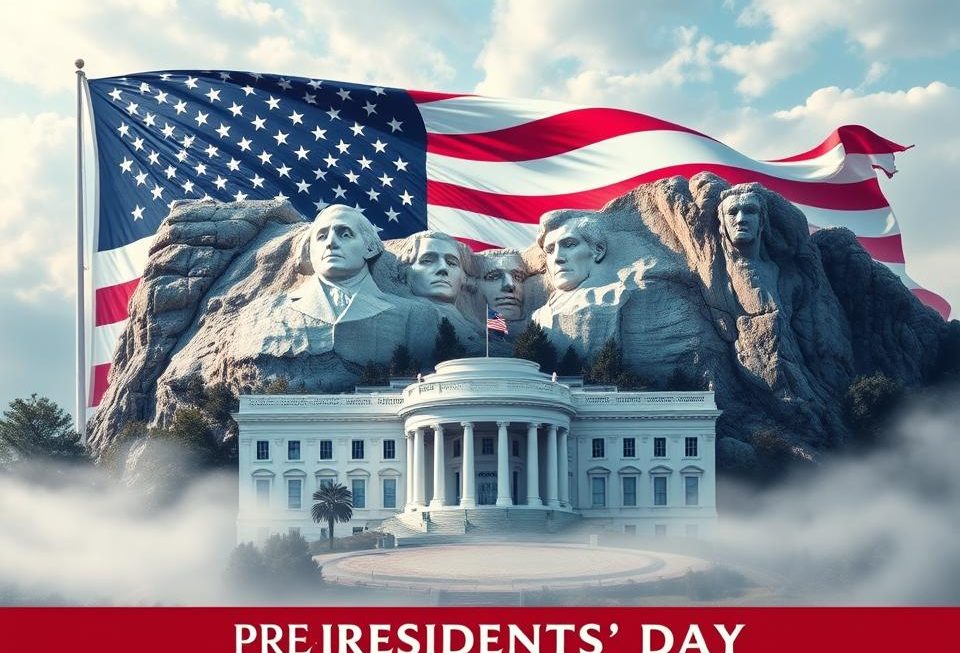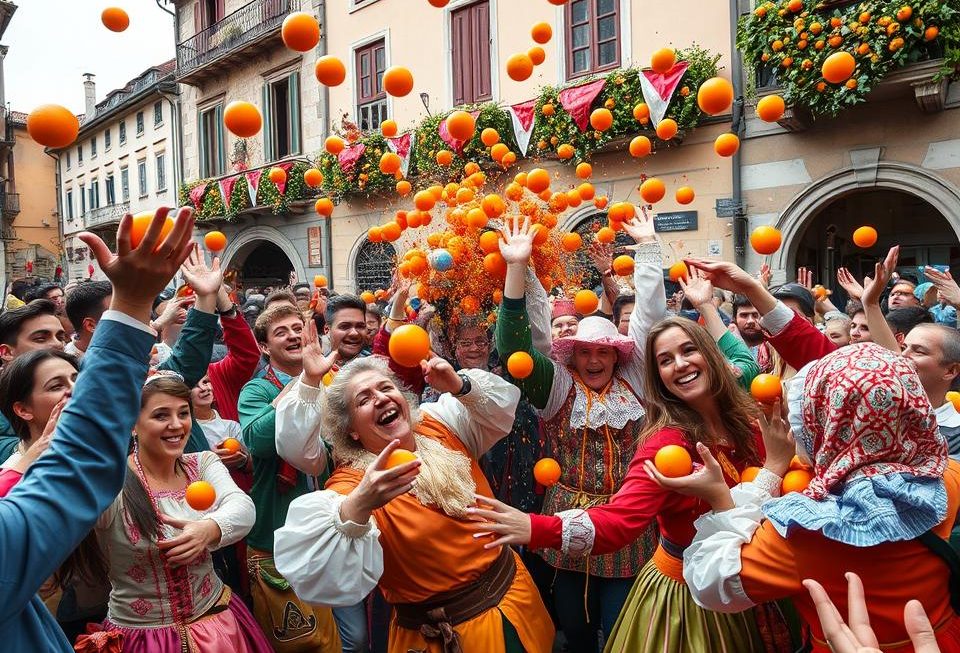Easter is a holiday filled with tradition and meaning. It’s celebrated worldwide with colorful eggs and the Easter Bunny. This spring event is full of history, customs, and fun. As Easter comes closer, we’ll explore its origins, traditions, and how it’s celebrated globally.
Read interesting things at : honjo-guruguru
Key Takeaways
- Easter has its roots in both pagan and Christian traditions, evolving over centuries to become a widely celebrated spring festival.
- Symbolic elements like eggs and bunnies are deeply intertwined with the holiday’s themes of renewal, fertility, and the resurrection of Christ.
- Families and communities around the world observe Easter through a diverse array of customs, from Lenten fasting to elaborate feasts and vibrant fashion choices.
- The Easter Bunny and the tradition of egg hunts have become beloved and iconic elements of the holiday, capturing the imagination of young and old alike.
- Easter celebrations are a time for spiritual reflection, joyful gatherings, and the creation of cherished memories that transcend cultural boundaries.
The Origins of Easter
Easter is a holiday with deep roots in both pagan and Christian traditions. It started with ancient spring celebrations and fertility rituals. These were common across many ancient cultures. As Christianity grew, it added these pagan traditions to the celebration of Jesus Christ’s resurrection. This created a holiday that mixed religious and cultural customs.
Pagan Roots and Christian Adoption
The name “Easter” comes from the Germanic goddess Eostre, linked to spring and fertility. Her festivals were held during the vernal equinox, marking the start of warmer weather and nature’s rebirth. Many ancient cultures, like the Egyptians, Babylonians, and Celts, had their own spring festivals to celebrate the sun and earth.
When Christianity spread in Europe, the church saw value in these pagan celebrations. It merged these with the Christian calendar to help convert pagans. This move was key in making Christianity popular in the region.
The Easter Bunny and Egg Symbolism
The Easter bunny and eggs come from pagan fertility rituals. The rabbit symbolized abundance and new life, while eggs stood for spring’s renewal. These symbols were taken up by Christianity, with eggs now symbolizing Jesus’ resurrection.
Decorating eggs, or “pysanky,” comes from ancient Slavic traditions. These decorated eggs were given as gifts during spring festivals, symbolizing life, death, and rebirth. The Christian church adopted this tradition, linking it to the resurrection story and new life.
The mix of pagan and Christian traditions has shaped the Easter we celebrate today. It’s a holiday with both religious and cultural elements that come together in a special way.
Easter Traditions Around the World
Easter is a big holiday celebrated in many ways around the world. In Latin America, you can see big processions. In Eastern Europe, people decorate eggs with care. These traditions show how different cultures and beliefs come together for Easter.
In Spain, Easter is known as “Semana Santa.” It’s a time of deep devotion. People carry floats and wear special clothes through the streets. The sounds of drums and brass bands fill the air.
When you visit Poland, you’ll see Easter in a unique way. “Wet Monday,” or “Śmigus-dyngus,” is when young people splash water on each other. This tradition is about cleaning and starting fresh.
“Easter is a time for family, reflection, and the celebration of renewal. Across the world, communities come together to honor this sacred holiday in their own unique ways.”
In Greece, Easter is special because of the “Lambatha.” It’s a big candle that stands for the light of the Resurrection. Families eat roasted lamb together, as a way to honor Christ.
| Country | Easter Tradition | Significance |
|---|---|---|
| Spain | Semana Santa Processions | Elaborate religious processions and penitence |
| Poland | Śmigus-dyngus (Wet Monday) | Playful water dousing for purification and renewal |
| Greece | Breaking of the Lambatha Candle | Celebration of the Resurrection with a shared feast |
These examples show how different places celebrate Easter. From processions to decorating eggs, each tradition is special. By learning about these customs, we see how Easter brings people together worldwide.
Preparing for Easter
As Easter approaches, Christians worldwide look forward to a time of joy. Lent, a 40-day period before Easter, is a key part of this. It’s a time for deep thought, penance, and spiritual growth.
Lenten Fasting and Spiritual Renewal
Fasting is at the core of Lent. It’s a way to show self-denial and sacrifice. Many give up certain foods or activities to focus on their spiritual health.
This fasting reminds us of Jesus Christ’s sacrifices. It leads us to his crucifixion and resurrection.
Lent is more than just fasting. It’s a chance to deepen our faith and connect with the divine. Christians pray more, study scripture, and help others. These actions help us feel closer to God.
- Lent gives Christians a chance to think about their lives and change for the better.
- Fasting helps us remember Jesus Christ’s sacrifices.
- Prayer and scripture study deepen our faith and prepare us for Easter.
As Lent ends, Christians look forward to celebrating Easter. They’re excited for the joy of Christ’s resurrection and their own spiritual renewal.
“During this season of Lent, we are invited to embrace the sacred opportunity for spiritual renewal and to reflect deeply on the profound meaning of Christ’s sacrifice and resurrection.”
Easter Egg Decorating
Decorating Easter eggs is a tradition that spans centuries and cultures. It ranges from the detailed pysanky of Ukraine to the bright eggs of Eastern Europe. This tradition is a mix of cultural customs and artistic skills.
Techniques and Cultural Variations
The Ukrainian pysanky is a famous way to decorate Easter eggs. It uses a stylus to apply wax, making patterns and designs. Then, the waxed areas stay white when dyed in different colors. This creates a unique egg that shows Ukrainian heritage and skill.
In Eastern Europe, egg dyeing is also a big deal. Eggs get colored with things like onion skins and beets. These colors make the eggs look amazing. The designs on the eggs have special meanings, adding to their cultural importance.
| Technique | Origin | Characteristics |
|---|---|---|
| Pysanky | Ukraine | Intricate wax-resist designs, jewel-toned colors |
| Egg Dyeing | Eastern Europe | Vibrant colors from natural dyes, symbolic motifs |
Now, Easter egg decorating is a global art form. People around the world add their own twist to this tradition. They use their culture and creativity to make these special eggs.
Easter eggs are more than just decorations. They are a way to celebrate heritage, be creative, and keep traditions alive. Decorating Easter eggs reminds us of the beauty of human culture and the power of art.
The Easter Bunny Tradition
The Easter bunny is a symbol of spring, but its roots go back to pagan fertility symbols. Rabbits were seen as symbols of fertility and new life. This made them perfect for the Christian Easter, which happens in spring.
In the 17th century, German immigrants brought the “Osterhase” (Easter hare) to America. This mythical rabbit was thought to leave eggs for good kids. This idea became the Easter bunny tradition we know today.
Now, the Easter bunny is everywhere in spring celebrations. You’ll see it in parades, cards, and finding easter eggs for kids. It’s more than a pagan fertility symbol. It’s a sign of joy and new life in the Easter season.
But the Easter bunny isn’t the only animal tied to Easter. In some places, the chick or lamb also symbolize the holiday. They stand for the rebirth and growth of spring.
The Easter bunny has become a key part of Easter. It brings happiness to both kids and adults. This spring holiday reminds us of the power of tradition and how symbols can change over time.
Easter Baskets and Treats
As Easter comes closer, making and giving Easter baskets is a big tradition. These baskets are filled with treats that make the holiday special. At the core are chocolate eggs and candies, bringing joy to the season.
Chocolate Eggs and Candies
The Easter basket tradition goes way back to ancient times. Eggs were symbols of new life and fertility. When Christianity spread, the egg became a sweet chocolate egg, symbolizing rebirth.
Now, the chocolate egg is key in Easter baskets. They come with many candies like jelly beans and Peeps. There are also special treats like Cadbury Crème Eggs and Reese’s Peanut Butter Eggs.
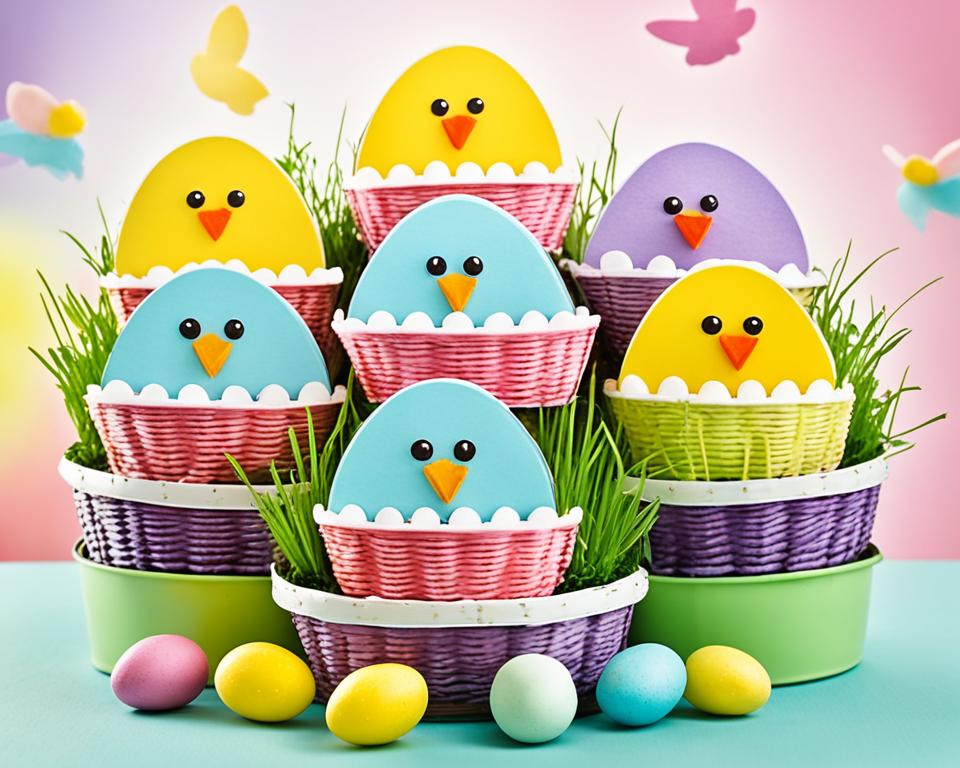
But Easter baskets aren’t just for chocolate eggs and candies. They can also have toys, trinkets, and useful things like socks or gift cards. Making these baskets is a special part of Easter.
Both kids and adults love the Easter basket and its treats. They bring back happy memories and fill us with joy. They also remind us of new beginnings.
Easter Celebrations
Easter is a time filled with joy, celebrated with many traditions worldwide. At its core, it’s about religious services and family gatherings. These events unite communities in a spirit of renewal and joy.
Religious Services and Family Gatherings
Easter Sunday is the highlight for many, with religious services at its center. These services are a time for deep thought and reflection. People come together to remember Jesus Christ’s resurrection through hymns, prayers, and communion.
But Easter isn’t just about church. It’s also a time for families to come together. Homes are filled with the smell of cooking as families prepare for a big Easter feast. They share traditional dishes, stories, and create memories that last a lifetime.
Easter celebrations don’t stop at home. Communities come alive with events like egg hunts, parades, concerts, and festivals. These events bring people together, creating a sense of unity and shared traditions.
Easter is a time of deep meaning, filled with both solemnity and joy. It’s a chance to reflect on life’s deeper meaning and celebrate together. It’s a season of hope, renewal, and coming together.
Easter Egg Hunts
Easter egg hunts are a fun tradition that brings families together. Kids love searching for hidden, decorated eggs. It’s a big part of Easter celebrations in many places.
The tradition of Easter egg hunts comes from old spring festivals. Eggs were seen as symbols of new life and fertility. When Christianity spread, the egg hunt became part of Easter, symbolizing Jesus Christ’s empty tomb.
- Now, Easter egg hunts are a favorite activity for kids. They get to explore outside and find hidden treasures.
- Churches, schools, and groups organize these hunts. They create a sense of community for families.
- Kids get really excited for Easter egg hunts. They look for eggs filled with candy or small prizes.
Planning Easter egg hunts can be different. Some have big themes, prizes, and activities. Others are competitive, where kids race to find the most eggs or special “golden eggs.”
| Location | Unique Easter Egg Hunt Traditions |
|---|---|
| Germany | The “Ostereisuche” or Easter Egg Hunt is a popular tradition, with children searching for eggs hidden in gardens and forests. |
| United States | Many communities host large-scale Easter egg hunts in public parks or fields, often featuring Easter Bunny appearances and other family-friendly activities. |
| United Kingdom | Some British families engage in “egg rolling” competitions, where hard-boiled eggs are rolled down hills or slopes. |
Easter egg hunts are a beloved tradition. They bring families and communities together for outdoor celebrations and children’s activities. These hunts remind us of the family traditions that make Easter special.
“The best thing about an easter egg hunt is not knowing what surprises are in store.”
Easter Feasts and Dishes
Easter is a time when families and communities come together, sharing meals filled with tradition. The feast includes dishes like ham and lamb, showing off the season’s flavors and our diverse food heritage.
Traditional Easter Meals and Recipes
The star of Easter is often a delicious ham or a tender lamb. These dishes are more than just food; they symbolize Christ’s sacrifice and the Paschal lamb.
The Easter table is full of side dishes and baked goods, each with its own taste and texture. You’ll find everything from buttery potatoes to golden biscuits and rich breads. Each dish adds something special to the feast.
| Traditional Easter Dish | Regional Variations |
|---|---|
| Ham | Honey-glazed, spiral-cut, baked with pineapple, smoked |
| Lamb | Roasted leg of lamb, lamb chops, lamb stew |
| Baked Goods | Hot cross buns, Italian Easter bread, Greek Easter bread, Polish babka |
| Side Dishes | Scalloped potatoes, roasted vegetables, deviled eggs, green bean casserole |
These traditional Easter meals and recipes do more than feed us. They connect us to our cultural and historical past. Whether they’ve been in the family for years or are new discoveries, these dishes are key to the Easter celebration. They let us enjoy the season’s flavors and the joy of coming together at the table.
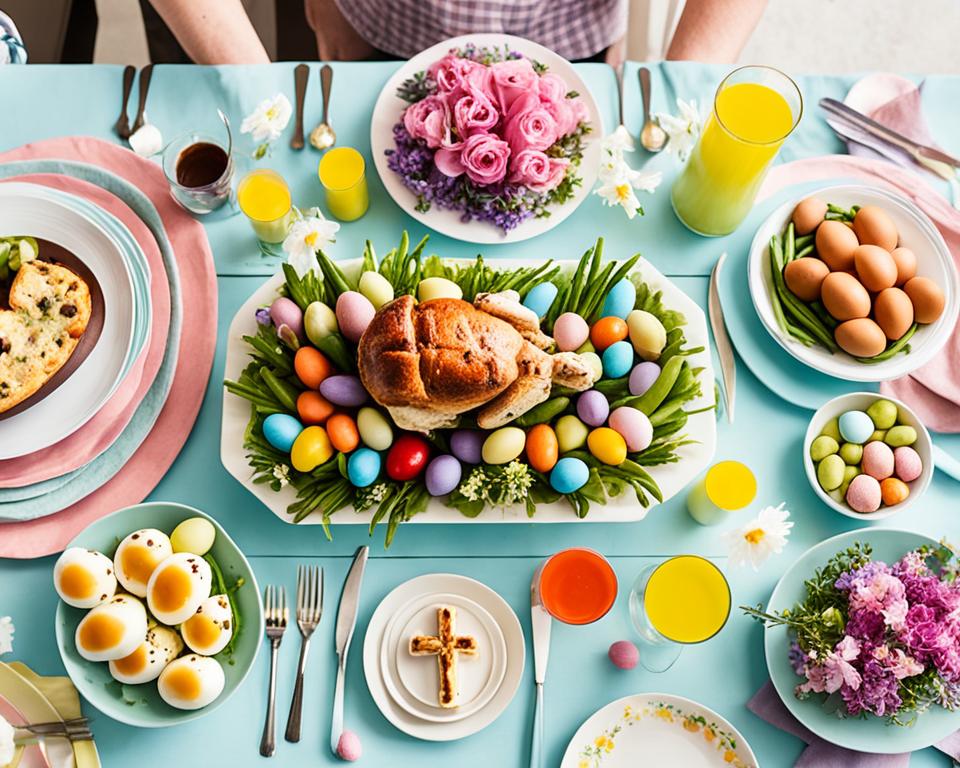
Easter Fashion and Colors
Spring brings a burst of life, and Easter’s fashion reflects this with vibrant colors and styles. Easter fashion features pastel colors and light fabrics, showing the mix of tradition and modern trends. These styles highlight the renewal and rebirth of the season.
Pastels are key to Easter fashion, with soft pink, lavender, mint, and pale blue being popular. These colors bring a feeling of purity and innocence. They match the beauty of spring flowers that come out during Easter.
Cultural influences also shape Easter fashion. In some places, traditional patterns and vibrant flowers decorate clothes. These designs show the holiday’s rich heritage and cultural diversity. Light fabrics like chiffon and cotton make the outfits perfect for the mild spring weather and outdoor activities.
| Trend | Description | Example |
|---|---|---|
| Pastel Colors | Soft, muted shades of pink, lavender, mint, and blue | Pastel pink sundress, lavender suit, mint green blouse |
| Floral Motifs | Delicate, springtime-inspired patterns and embroidery | Floral-printed midi skirt, embroidered blouse, floral headpiece |
| Lightweight Fabrics | Airy, breathable materials like chiffon, linen, and cotton | Linen button-down shirt, chiffon maxi dress, cotton jumpsuit |
Easter fashion combines soft pastel colors, cultural touches, and light fabrics. It captures the season’s spirit and the holiday’s renewed feeling. From formal outfits for church to casual looks for egg hunts, Easter fashion keeps evolving. It blends tradition with modern tastes, making it a beloved part of the celebration.
Easter in Pop Culture
Easter is more than just a holiday; it’s a big part of popular culture. It’s seen in movies, TV shows, ads, and social media. The impact of easter in pop culture is huge.
Over time, how Easter is shown in media has changed. Movies like “Hop” and “The Passion of the Christ” have shown different sides of Easter. They highlight its spiritual and cultural importance.
Business has also shaped how we see Easter. You can find Easter-themed items everywhere, from sweets to clothes. This has made Easter a big money-maker for companies. Now, Easter is often linked to buying lots of things.
Social media has made Easter even more popular. People share their Easter moments, creative ideas, and the latest ads online. This has changed how we celebrate Easter and see it.
Easter in pop culture keeps growing. It’s clear the holiday means more than its religious roots. Media and business have made Easter a big part of our culture. This has kept the holiday popular and loved by many.
Easter and the Resurrection
The Easter season is at the heart of Christianity. It celebrates the resurrection of Jesus Christ. This event is key to Christian beliefs and has deep religious and theological meaning.
Jesus’ resurrection happened three days after his death. It’s seen as a victory of life over death. It shows the triumph of good over evil and fulfills God’s promise of salvation.
Easter is more than remembering a historical event. It’s a time for spiritual renewal and a reminder of faith’s power. It shows the hope that is central to Christianity.
Christian art, liturgy, and devotion often focus on the resurrection. The empty tomb and joyful hymns inspire and reflect on Jesus’ resurrection. This has been celebrated by Christians for centuries.
| Theological Significance | Symbolic Meaning | Cultural Influence |
|---|---|---|
| The resurrection affirms the divinity of Jesus and the promise of eternal life. | The egg and the rabbit symbolize rebirth, fertility, and new life. | Easter traditions, such as egg decorating and the Easter bunny, have evolved from pagan and Christian influences. |
The Easter resurrection’s deep meaning shapes beliefs and practices worldwide. It’s a celebration of faith that is transformative and lasting.
Conclusion
The journey through Easter’s traditions, history, and celebrations has been enlightening. From ancient roots to today, Easter has become a global favorite. It goes beyond religion and culture, touching everyone’s heart.
People around the world unite to celebrate Easter in many ways. They attend religious services, enjoy cultural events, or share special treats. Easter shows our deep need for renewal and the joy of life’s cycle.
As we end our look at Easter, we value its history and modern-day celebrations more. This article shows how Easter connects us all. It’s a symbol of human connection, tradition, and the joy of life’s special moments.
